Scanning the Original and Sending to a Computer
0C1Y-1U9
By changing the paper document to PDF or XPS, you can send the file to shared folder on the computer.
Benefits from Changing the Paper Document to PDF or XPS
You can save space.
You can improve search performance of the text on the document.
Reduction in printing costs and conservation of paper resources
You can set a password for security. (PDF only)
|
Required Condition
|
|
The Send function can be used on this machine.
You can connect to the computer with the shared folder from this machine via the network.
|
This section describes how to create a "PDF-Scan" shared folder on a drive of a Windows computer that is connected to the machine via the SMB protocol and send a scanned two-sided document to that folder as a PDF file.
The screens may differ, depending on the model of the machine and on attached optional products.
The screens may differ, depending on the operating system of your computer.
Follow the procedures below.
Creating a Shared Folder
Registering an Address
Sending from the Machine
If You Are Using Windows:
1.
Check for the computer name.
For Windows XP, right-click [My Computer] → click [Manage] → right-click [Computer Management (Local)] → click [Properties] → check for the computer name on the [Computer Name] sheet.
For Windows Vista/Windows 7, click [

] (Start) → right-click [Computer] → click [Properties] → check for the computer name.
For Windows 8, place the cursor on the top right (bottom right) of the desktop → right-click [Computer] → click [Properties] → check for the computer name.
For Windows 7
2.
Right-click a blank area on the desktop → click [New] → [Folder] to create a new folder → enter 'PDF-Scan' as the folder name.
3.
Select [Share this folder].
For Windows XP, right-click the "PDF-Scan" folder → select [Properties] to display the [PDF-Scan Properties] dialog box → click the [Sharing] tab → select [Share this folder] → click [Permissions].
For Windows Vista/Windows 7/Windows 8, right-click the "PDF-Scan" folder → select [Properties] to display the [PDF-Scan Properties] dialog box → click the [Sharing] tab → click [Advanced Sharing] → select [Share this folder] → click [Permissions].
|
NOTE
|
|
If [Permissions] is not displayed in the [Sharing] tab, click [Tools] → [Folder Options] → [View] → deselect [Use simple file sharing].
For more information, see the manual provided with Windows XP.
|
For Windows 7
4.
Select [Everyone] → check that [Allow] for <Change> is selected → click [OK]. If [Allow] is not selected, select [Allow] → click [OK].
For Windows 7
5.
For Windows XP, in the [PDF-Scan Properties] dialog box, click the [Security] tab → click [Add]. For Windows Vista/7/8, in the [PDF-Scan Properties] dialog box, click the [Security] tab → click [Edit] → [Add].
6.
Enter 'Everyone' → click [OK].
7.
For Windows XP, select [Everyone] → select [Allow] for <Modify> → click [OK]. For Windows Vista/7/8, select [Everyone] → select [Allow] for <Modify> → click [OK] → [Close].
For Windows 7
A shared folder to send data is created.
|
NOTE
|
For Windows XP, the shared folder is displayed as  . For Windows Vista/7, the shared folder is displayed as  . |
You can specify the settings to use the shared folder ([Public] folder).
1.
Click [Sharing] on the [System Preferences] screen.
2.
Select [File Sharing].
The [Public] folder is now shared on the network.
You can share files in [Drop Box] in [Public]. You can access the [Drop Box] as follows: On the [Go] menu, click [Home] → [User] → select the login user name → [Public] → [Drop Box].
|
NOTE
|
|
The appearance of the screen may differ from the one you actually see, depending on the version of the operating system you are using.
|
You can perform this procedure using the touch panel display or the Remote UI. Using the Remote UI, you can register a destination with ease.
1.
Start your Web browser → enter the IP address of the machine in [Address].
http://<IP address of the machine>
The portal page of the Remote UI is displayed.
|
NOTE
|
If you want to confirm the IP address of the machine, press  (Settings/Registration) on the control panel and follow the procedure below. Press  (Settings/Registration) → [Preferences] → [Network] → [TCP/IP Settings] → [IPv4 Settings] → [IP Address Settings]. If you cannot access the above settings, specify the proxy exclusion settings following the procedures below.
|
(1)
|
Click [Tools] on the Internet Explorer menu bar → [Internet Options] → [Connections] tab → [LAN Settings].
|
|
(2)
|
Select [Use a proxy server for your LAN (These settings will not apply to dial-up or VPN connections).] → click [Advanced].
|
|
(3)
|
Enter the IP address of the machine in [Do not use proxy server for addresses beginning with:] → click [OK].
|
If the following error messages are displayed and you cannot access the Remote UI, follow the procedures below.
Page Not Found:
|
(1)
|
Click [Tools] on the toolbar → [Internet Options] → select the [General] tab → click [Delete Files] in [Temporary Internet Files].
|
|
(2)
|
Select [Delete all offline content] on the Delete Files screen → click [OK] → restart the Web browser and access the Remote UI again.
|
HTTP 404 File Not Found:
Check the IP address. Check the IP address range settings in the Network settings of the machine.
|
2.
Click [Address Book] → [Address List 01] on the Address List screen.
3.
Click [Register New Destination]. A screen for registering a new destination is displayed.
4.
From the Type drop-down list, select [File] → click [Set].
5.
Specify the desired settings on the [Register New Destination: File] screen → click [OK].
|
Name:
|
Enter a name for the destination. You can specify a desired name.
|
|
Protocol:
|
Select [Windows SMB].
|
|
Host Name:
|
\\Computer Name\PDF-Scan (For the computer name, if you are using Windows, enter the computer name that you created in step 1 of "Creating a Shared Folder (Windows)." If you are using a Macintosh, enter the computer name that you checked in step 2 of "Creating a Shared Folder (Mac).")
|
|
Folder Path:
|
If you want to create a folder named "Temporary" in the PDF-Scan folder, enter '\Temporary'. You can send without entering this field.
|
|
User Name:
|
Enter the sender's user name (the name used to log in to the computer).
|
|
Confirm Before Sending
|
Select to display the confirmation screen before sending.
|
|
Password:
|
Enter the password that corresponds with the user name.
|
|
Confirm:
|
Reenter the same password for confirmation.
|
The destination you entered is registered.
Using the Touch Panel Display
1.
Press [Scan and Send] on the Main Menu screen.
|
NOTE
|
|
If the Main Menu screen is not displayed, press [Main Menu].
|
2.
Select [Address Book].
3.
Press [Other Ops.] → [Register/Edit].
4.
Press [Register New Dest.] → [File].
5.
Press [Name] → enter a new name for the file → press [Next].
|
[Name]:
|
Enter a name for the destination. You can specify a desired name.
|
6.
Specify each setting.
|
<Protocol>:
|
Select [Windows SMB].
|
|
[Host Name]:
|
Enter the computer name that you checked in step 1 in "Creating a Shared Folder (Windows)", or step 2 in "Creating a Shared Folder (Mac)." You can also press [Search Host] to search for the destination computer.
|
|
[Folder Path]:
|
Specify the folder of the destination computer to save to. You can also press [Browse] to specify the folder of the destination computer.
|
|
[User Name]:
|
Enter the sender's user name (the name used to log in to the computer).
|
|
[Password]:
|
Enter the password that corresponds with the user name.
|
7.
Press [OK].
You can create an OCR (Text Searchable) PDF file from a two-sided original.
1.
Place your originals in the feeder → press [Scan and Send] on the Main Menu screen.
|
NOTE
|
|
If the Main Menu screen is not displayed, press [Main Menu].
|
2.
Press [Address Book].
3.
Select a registered destination → press [OK].
4.
Press the file format button.
5.
Select [PDF] → press [Set Details].
6.
Press [OCR (Text Searchable)] → [OK].
7.
Press [Options].
8.
Press [2-Sided Original] → specify the type of two-sided original → press [OK].
If you are scanning LTR and LGL originals loaded in the feeder at the same time, select [Auto (LTR/LGL)] on the Select Paper screen.
9.
Press

(Start).
The document is changed to searchable PDF, and is sent and stored in the shared folder.
You can convert original color/grayscale images scanned at a resolution of 300 dpi to compact (approx. 1/10 original size) PDF or XPS files. This mode eliminates the issue of the large file size of digitized documents, reducing color documents to the size of black-and-white documents. This also enables you to reduce the load on the network and servers. For details, see
"Compact PDF or XPS."Searchable PDF, XPS, or OOXML
This mode enables you to perform OCR (optical character recognition) to extract data that can be recognized as text from the scanned image, and add it as a transparent layer of text to create a PDF, XPS, or OOXML file that is searchable. If the file is a searchable PDF file, you can quickly search for the necessary information on the PDF, XPS, or OOXML. For details, see
"Searchable PDF/XPS/OOXML."Trace & Smooth PDF (Universal Send Trace & Smooth PDF Kit Is Required)
This mode enables you to divide and extract the text, line drawings, and background of a scanned image, and convert the text and line drawings to scalable outline data to be placed on the background when creating a PDF file. For details, see
"Trace & Smooth Settings."Enhanced text quality
Outlining the text edges eliminates "jagginess" even when the text is enlarged, enhancing the overall quality of the text in the PDF.
Practical application of data
The outlined data on the PDF can be extracted and used in Adobe Illustrator.
|
NOTE
|
|
The Trace & Smooth PDF mode can be used with the Searchable PDF, Encrypted PDF, Digital Signatures, and PDF Files with a Security Policy modes.
Trace & Smooth PDF is linked with Compact PDF. Thus, if you select the Trace & Smooth PDF mode, Compact PDF is automatically set and the PDF file size is reduced.
If you select Trace & Smooth for the PDF file format, the resolution must be set to 300 dpi, and color or grayscale must be specified.
|
You can set a password for a PDF file. If a PDF file is encrypted with a password, you cannot open, print, or change the PDF file without entering the correct password. If you want to restrict access, it is recommended that you set a password before sending. For details, see
"Encrypting PDF Files."Changing the Default Settings
By storing the specified send settings as the default settings, you can recall the settings without specifying the settings again. For details, see
"Changing the Default Settings for Send."If You Cannot Use SMB to Communicate with Windows
If you cannot use SMB to communicate with Windows, follow the procedures below.
Firewall:
For Windows XP
Right-click [My Network Places] → select [Properties] → right-click [Local Area Connection] → select [Properties] → click the [Advanced] tab → click [Settings] → click the [General] tab → click [Off] → [OK].
For Windows Vista
Right-click [Network] → click [Properties] → [Windows Firewall] → [Turn Windows Firewall on or off]→[Change settings] → select [Off] → [OK].
-For Windows 7
Right-click [Network] → click [Properties] → [Windows Firewall] → [Turn Windows Firewall on or off]→[Turn Windows Firewall on or off] for [Home or work (private) network location settings] and [Public network location settings]→ select [Off] → [OK].
For Windows 8
Place the cursor on the top right (bottom right) of the desktop → select [Settings] → [Control Panel] → [Windows Firewall] → [Turn Windows Firewall on or off] → select [Turn off Windows Firewall (not recommended)] for [Private Network settings] and [Public Network settings] → [OK].
Shared Simple File Settings:
For Windows XP
Click [Start] → [Control Panel] → [Folder Options] → the [View] tab → select [Use simple file sharing] for [Advanced Settings] → [Apply].
For Windows Vista
Right-click [Network] → click [Properties] → click the arrow on the right of [File Sharing] for [Sharing and Discovery] → select [Turn on file sharing] → [Apply].
For Windows 7
Right-click [Network] → click [Properties] → [Change advanced sharing
settings] → select [Turn on network discovery] → [Turn on file and printer sharing] → [Save Changes].
For Windows 8
Place the cursor on the top right (bottom right) of the desktop → select [Network] → [Properties] → [Change advanced sharing settings] → select [Turn on network discovery] → [Turn on file and printer sharing] → [Save Changes].
Properties of the Shared Folder:
Right-click the shared folder → select [Properties] → click the [General] tab → deselect [Read-only] → [Apply].
Access Privilege of the Shared Folder ([Sharing] Sheet):
Right-click the shared folder → select [Properties] → click the [Sharing] tab → select [Permissions] → [Apply].
Security Policy:
Click [Start] → [Control Panel] → [Administrative Tools] → [Local Security Policy] → [Local Policies] → [Security Options] → [Microsoft network server: Digitally sign communications (always)] → [Disabled] → [Apply] → restart Windows.
Login Password:
If you are using Windows, you can login to the computer using a local account without a password set. However, the following issues may arise:
If <Check the login destination, user name, and password> is displayed, you cannot set the login/destination from the machine.
You can set the login/destination from the machine, but you cannot use the Push Scan function.
The above issues related to accounts with no specified password arise because authentication was not performed at the time the folder on the network was accessed.
From a security perspective, and to avoid the above issues, login using an account with a password.
Logging in an Active Directory Environment:
When a computer that one or more users log on to is restricted by the system administrator in an Active Directory environment, follow the procedure below to register the name of the computer.
Open the user account properties dialog box. Click [Logon To] to open the [Logon Workstations] dialog box → set the computer name in the user account properties dialog box to "CANON + the last 8 digits of the MAC address of the computer + 00". For example, if the MAC address of the computer you are using is "00:00:11:22:33:44", set "CANON1122334400".
 e-Manual
e-Manual Site map
Site map Help
Help Glossary
Glossary Category Top
Category Top Preface
Preface Digitizing Paper Documents
Digitizing Paper Documents Scanning the Original and Sending to a Computer
Scanning the Original and Sending to a Computer  Adding an Image Scanned via Network Scanner to a Document
Adding an Image Scanned via Network Scanner to a Document Converting Scanned Documents into Encrypted Searchable PDF
Converting Scanned Documents into Encrypted Searchable PDF Using an Advanced Box on the Network
Using an Advanced Box on the Network Printer Driver
Printer Driver Merging and Printing Multiple Documents (Windows)
Merging and Printing Multiple Documents (Windows) Using Profiles to Print (Windows)
Using Profiles to Print (Windows) Selecting Presets for Printing (Mac)
Selecting Presets for Printing (Mac) Specifying the Printer Driver Default Settings (Windows)
Specifying the Printer Driver Default Settings (Windows) Fax
Fax Temporarily Storing and Viewing Received Image
Temporarily Storing and Viewing Received Image Automatically Forwarding Received Faxes
Automatically Forwarding Received Faxes Automatically Forwarding Received Faxes to a Computer
Automatically Forwarding Received Faxes to a Computer Forwarding to a Mobile Computing Device
Forwarding to a Mobile Computing Device Forwarding Received Faxes
Forwarding Received Faxes Handling Files with Forwarding Errors
Handling Files with Forwarding Errors E-Mail
E-Mail Sending an E-mail to Multiple Destinations
Sending an E-mail to Multiple Destinations  Using a Shared Address Book
Using a Shared Address Book Internet Fax/Intranet Fax
Internet Fax/Intranet Fax Sending a Document via Internet Fax
Sending a Document via Internet Fax Receiving a Document via Internet Fax
Receiving a Document via Internet Fax Department ID Management
Department ID Management Setting a Department ID for Copying
Setting a Department ID for Copying Setting the Department ID Management on the Printer Driver
Setting the Department ID Management on the Printer Driver Security
Security System Management
System Management Copy Security with Forced Secure Watermark
Copy Security with Forced Secure Watermark Secured Print
Secured Print  Data Security
Data Security Specifying Send/Fax Security Settings
Specifying Send/Fax Security Settings Restricting Access to the Machine (IPv4)
Restricting Access to the Machine (IPv4) Restricting Access to the Machine (IPv6)
Restricting Access to the Machine (IPv6) Advanced Copying and Printing
Advanced Copying and Printing Scanning Originals while the Machine is Processing a Job (Reserve Copy)
Scanning Originals while the Machine is Processing a Job (Reserve Copy) Printing Files Stored in USB Memory Directly from the Machine
Printing Files Stored in USB Memory Directly from the Machine Creating Address Labels by Scanning Business Cards
Creating Address Labels by Scanning Business Cards Customizing the Screen Display
Customizing the Screen Display Making Favorite Keys Highly Visible
Making Favorite Keys Highly Visible  Registering a Series of Frequently Used Functions in One Button (Quick Menu)
Registering a Series of Frequently Used Functions in One Button (Quick Menu) Recalling the Quick Menu of Another Machine
Recalling the Quick Menu of Another Machine Linkage Between imageRUNNER ADVANCE Desktop and imageRUNNER ADVANCE
Linkage Between imageRUNNER ADVANCE Desktop and imageRUNNER ADVANCE Automatically Importing Received FAX Documents into Library (imageRUNNER ADVANCE Desktop)
Automatically Importing Received FAX Documents into Library (imageRUNNER ADVANCE Desktop) Sending a Fax from a Computer (imageRUNNER ADVANCE Desktop)
Sending a Fax from a Computer (imageRUNNER ADVANCE Desktop) Performing Complex Tasks at the Touch of a Button: Workflow Composer
Performing Complex Tasks at the Touch of a Button: Workflow Composer Creating a Flow on a Computer (Workflow Composer)
Creating a Flow on a Computer (Workflow Composer) Duplicating/Editing a Flow to Create a Personal Flow (Workflow Composer)
Duplicating/Editing a Flow to Create a Personal Flow (Workflow Composer) Executing a Flow on the Machine (Workflow Composer)
Executing a Flow on the Machine (Workflow Composer)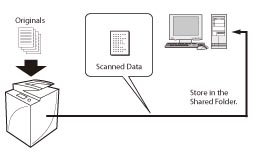
 ] (Start) → right-click [Computer] → click [Properties] → check for the computer name.
] (Start) → right-click [Computer] → click [Properties] → check for the computer name.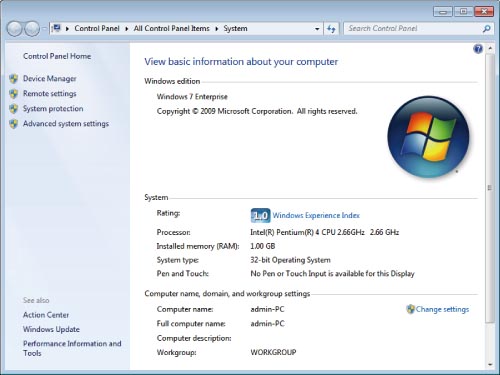
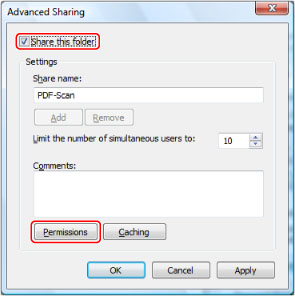
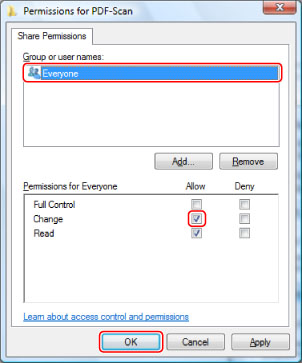
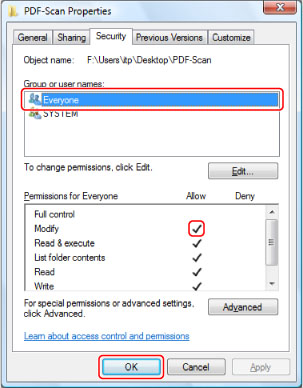
 . For Windows Vista/7, the shared folder is displayed as
. For Windows Vista/7, the shared folder is displayed as  .
.
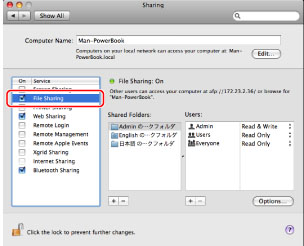
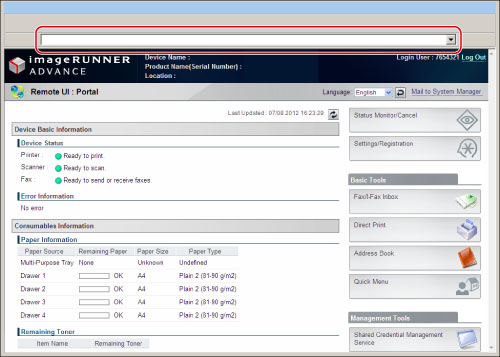
 (Settings/Registration) on the control panel and follow the procedure below.
(Settings/Registration) on the control panel and follow the procedure below.  (Settings/Registration) → [Preferences] → [Network] → [TCP/IP Settings] → [IPv4 Settings] → [IP Address Settings].
(Settings/Registration) → [Preferences] → [Network] → [TCP/IP Settings] → [IPv4 Settings] → [IP Address Settings].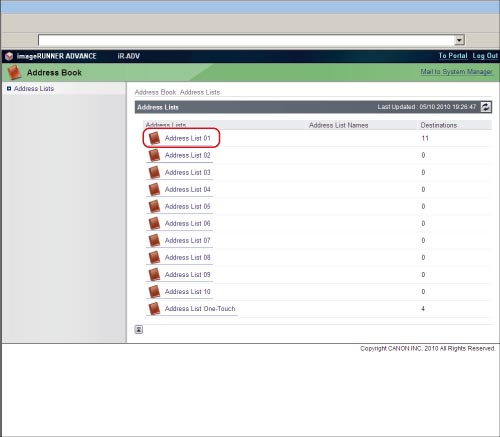

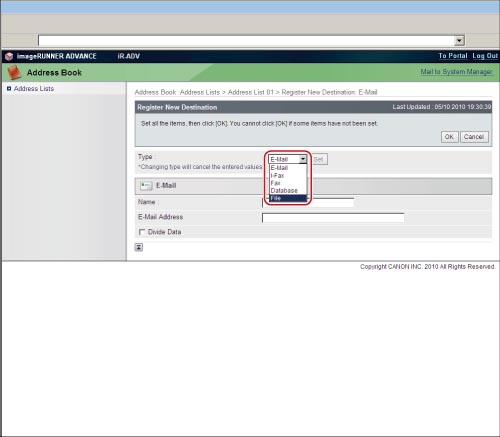
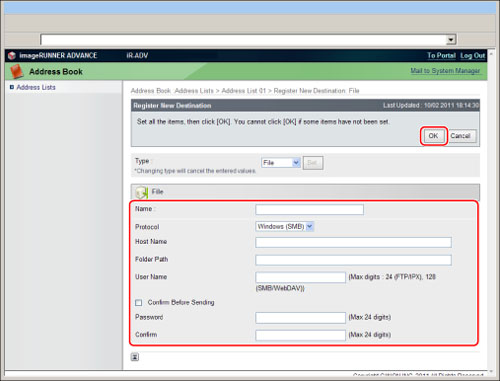
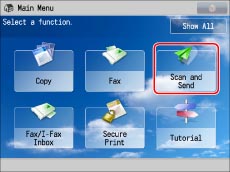

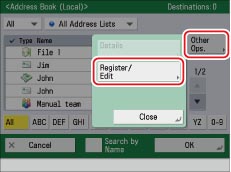
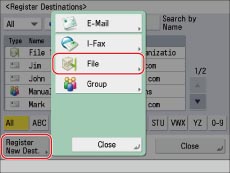
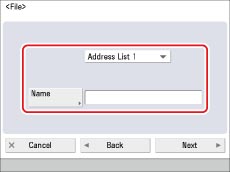
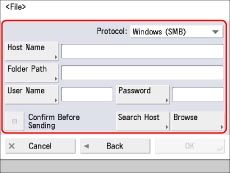

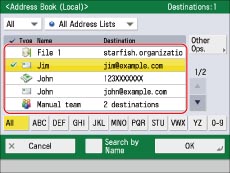

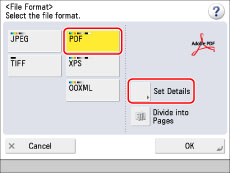


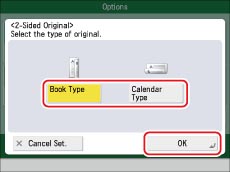
 (Start).
(Start).